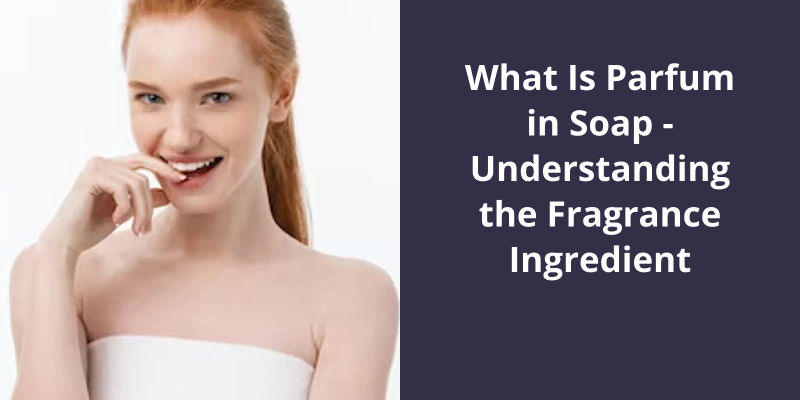Parfum in soap refers to the fragrance or scent that is added to the soap. It is a blend of various essential oils, aroma compounds, fixatives, and solvents that create a specific smell. This ingredient is used in soaps to provide a pleasant experience during use, mask the smell of other ingredients, and leave a lingering scent on the skin. Despite enhancing the sensory appeal of the product, parfum in soap can sometimes trigger allergies or sensitivities in people with sensitive skin. Therefore, it’s advisable to opt for fragrance-free soaps if you have such skin concerns.

What Is Parfum in Body Wash?
In body wash, parfum is often used to provide consumers with a more luxurious, sensory experience during their daily routine. However, what most consumers don’t realize is that the fragrances used can have negative effects on their skin. Parfum is often a mixture of chemicals, some of which can be harmful, especially for those with sensitive skin.
The chemicals used to create these fragrances can cause a host of problems, from worsening pre-existing skin conditions to irritating the skin in general. This can lead to an increase in dryness, itchiness, and redness.
As a result, many companies have started to offer fragrance-free options for those who’re sensitive to these scents. These products are often less indulgent in their sensory experience, but they provide a safer, more practical alternative for consumers with sensitive skin.
The Different Types of Fragrances Used in Body Wash, Including Natural and Synthetic Scents, and Their Potential Effects on the Skin.
This article discusses the various fragrances utilized in body washes and their possible impacts on the skin, such as natural and synthetic scents.
However, there’s often confusion about whether parfum is a natural ingredient or not. While some fragrances may contain natural extracts, the term “parfum” on product labels typically refers to a synthetic blend of chemicals that mimic a particular scent. This raises questions about the safety and sustainability of using parfum in consumer products.
Is Parfum a Natural Ingredient?
It’s composed of a mixture of natural and synthetic ingredients intended to create a specific aroma. When placed in personal care items such as perfumes, deodorants, and lotions, it adds a pleasant scent to the product while providing a sense of luxury and allure.
One of the primary components of parfum is essential oils, which are natural and extracted from plants. These essential oils offer a variety of fragrant notes and have been used for centuries in personal care products. However, it’s difficult for essential oils to produce complex fragrances on their own, so they’re often combined with synthetic materials to create a more complex aroma.
On the other hand, synthetic chemicals are an integral part of parfum. These chemicals came into being when the demand for perfume raw materials outstripped the supply of natural ingredients. Synthetic chemicals grew in popularity because they’re more efficient and less expensive to create. Scientists can also control the precise aroma created, making it easier to replicate fragrances and to create new ones.
However, synthetic parfum ingredients sometimes carry health concerns, with some reports linking them to allergies and respiratory problems. To prevent potential health hazards, some people prefer to use natural scents such as essential oils. While essential oils contain organic ingredients, they can trigger allergies and sensitivities in some individuals.
The Differences Between Natural and Synthetic Fragrances, Including Their Environmental Impact.
Natural fragrances are derived from plant-based sources, while synthetic fragrances are created in a lab using a combination of chemicals. Natural fragrances may be more environmentally friendly as they don’t require as much energy or chemicals to produce. However, synthetic fragrances can be more cost-effective and offer a wider range of scents. Both types of fragrances have potential environmental impacts, such as the use of pesticides in natural fragrance production or the release of volatile organic compounds with synthetic fragrances.
Conclusion
In conclusion, the inclusion of parfum in soap labels can often be confusing for consumers who’re unaware of it’s actual composition and ingredients. Many companies tend to keep their fragrances undisclosed, making it difficult for individuals with allergies or sensitive skin to make informed decisions about the products they use. While fragrance dispersants such as diethyl phthalate are frequently included in these undisclosed mixtures, the long-term implications of their use remain unclear. Ultimately, there’s a pressing need for increased transparency in labeling practices surrounding fragrance ingredients, so that consumers can make more informed decisions about the products they choose to bring into their homes and onto their bodies.




